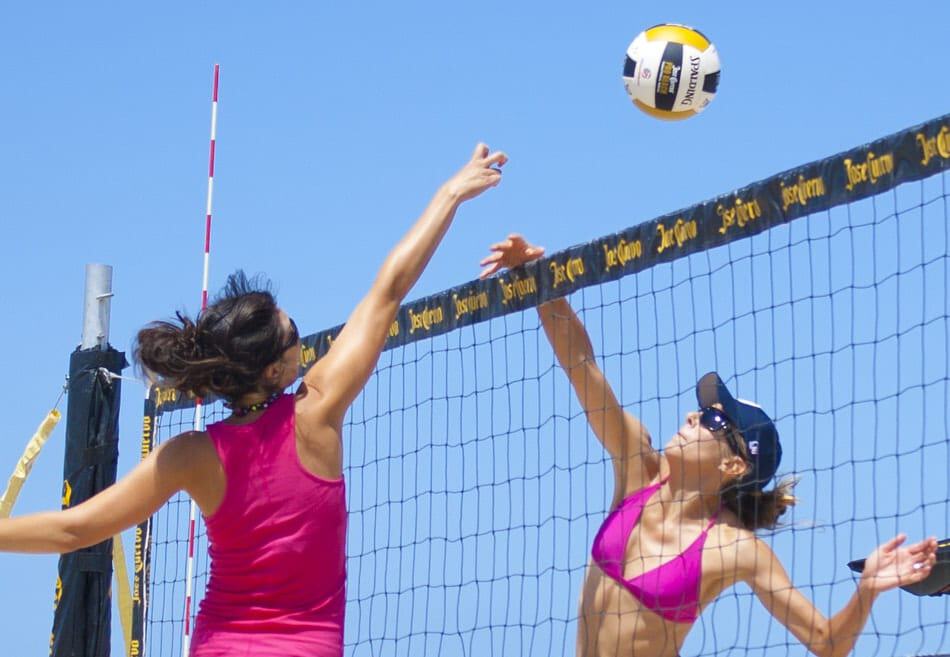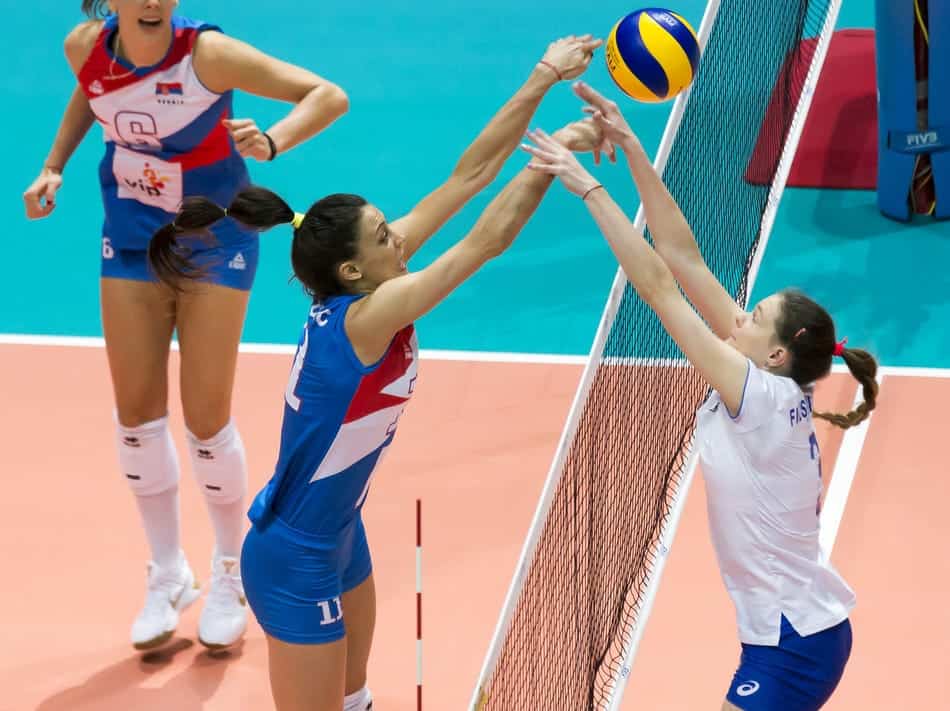A tip (or dink) in volleyball is often thought of as a good way to save a broken play in volleyball. However, strong volleyball teams use this move to mix things up and strategically gain an advantage over the opposing team. Do you understand tipping and does your team use it correctly? Are you only tipping when absolutely necessary or are you learning to use tipping as a much-needed element of surprise to throw off your opponents?
What is a tip in volleyball? When a player uses one open hand or knuckles, instead of the palm of the hand, to control the direction of the ball while sending it over the net, it is called a tip. Tipping is a softer, slower attack which can send the ball either short or deep in the court and surprise the offense.

In normal play, attacking your opponents involves swinging the arm to hit or spike the ball at high speed over the net. Tipping is quite different from this and isn’t as common in every rally.
While tipping is often used to save the team from a poorly-played ball, players (and most-certainly their coaches too) can see how it can be used strategically to gain the upper hand. And that is precisely why they spend time practicing tipping and learning when to use it.
Read on to learn more about why tipping is effective, the 2 main methods of tipping, and the key elements of effective tipping.
Is Tipping Only A Bail Out Strategy?
Tipping is a great “bail-out strategy” in volleyball when your offense doesn’t flow as smoothly as it’s supposed to. Sometimes the set is a little off-target or the hitter’s approach is wrong and they have to tip.
Other times the opposing team has really solid blocking and is ready and waiting for you. So a well-timed tip may bail you out of trouble, but that is not all that tipping is good for.
By incorporating this move into your overall offensive strategy, you can score more points, win more games, and boost your overall team success and morale. Using tipping strategically is about the element of surprise which often leads to winning the point.
Winning in volleyball is often about keeping the opposing team on its toes by not being too predictable in terms of techniques and strategies. A good tip makes this possible.
Tipping can be used to disrupt the defense of the other team or to score. In many instances, it will take the opposition by surprise, as they will naturally be on their heels and not as prepared for this type of unexpected play.
2 Main Methods Of Tipping – What You Need To Know
Indoor volleyball and beach volleyball have different rules and that’s why it is important to know the different types of tipping methods and when they are allowed to be used. For instance, if you use open hand tipping techniques during a beach volleyball game, it will be considered illegal. You will be breaking the rules.
Tipping can be done in 2 main ways as follows:
1. How to tip with an open hand in volleyball:
Remember not to make your intention to tip obvious to your opponent, don’t give anything away! This requires a certain level of deception on the court.
You can do this by using your normal approach as if you are going in for a spike or hit. Then, with your open hand, use your finger pads to hit in the middle or underside of the volleyball.
Hit it hard enough to give the ball a boost just over the block or just over the lip of the net. With this method, you have complete control over where the ball will land. Once you’ve practiced this skill you should be able to place it very short, in an open space, or even very deep in the court.
2. How to tip using your knuckles in volleyball:
When you tip the ball using your knuckles, this is called a dink. In beach volleyball games – it is illegal to tip the ball with an open hand, so most players use their knuckles.
To do this, approach in the same way as if you are going in for a spike or hit. You can swing your arm, so as not to give anything away to your opponents. While swinging, make a fist with your hand and use 2 or 3 knuckles to hit the ball.

You will be able to manipulate the direction of the ball with your knuckles, so use flat knuckles to get this right. Hit fairly hard on the bottom and middle of the volleyball to give it height over the block while directing it to your intended target.
To read more about beach volleyball, visit this recent article called Should I Switch From Indoor to Beach Volleyball?
How Often Should You Tip?
Go easy on tipping…too much tipping can, in fact, be too much!
It is important not to overdo it with tipping. Tipping is only very effective if you mix it up between spiking the ball hard with topspin.
If you keep tipping, it loses its element of surprise and becomes more predictable and less strategic. Sometimes you should tip when you are expected to hit and hit when you are expected to tip.
This goes hand-in-hand with the surprise attack of using a setter dump. Once or twice per match, that move will be golden. Do it too often and you’re just giving up an easy freeball.
Learn more about using a setter’s dump by reading this article’s Setting Tip #13.
Key Elements of Effective Tipping in Volleyball
When you learn the basics of volleyball, tipping or dinking will certainly be covered by your coach. And you will learn that there are 2 main elements to effective tipping.
Keep these in mind during practices and games so that you can be effective and efficient.
The 2 main elements of effective tipping are:
1. Deception

It is important to keep your intentions to tip a secret. To get this right, the team should practice deceptive play. To do so, approach as if you are going in for a normal attack. Approach hard, keep the elbow high as if you are going to spike, and at the very last moment, change to a tip technique.
2. Placement
If you want to tip effectively, you really need to ensure that you place the ball correctly. You can’t simply tip with no strategy or without at least noting the opposition.
To really succeed, notice the position of the defense. You need to tip the ball in such a way that it lands between the defensive blockers, any players covering the space beside or directly behind the blockers, and back row players.
Find the gaps or the seams that no one is covering. This creates chaos for the other team.
How To Improve Tipping Technique In Volleyball
As a volleyball team, you want to perfect your strategy and techniques. Some coaches may not focus on tipping in practice, but just coach how to defend tips.
Tipping should not be overlooked during practices – in fact, try to pay some special attention to it to ensure all team members know their roles. To improve your tipping, consider the following tips:
Turn your tipping into a highly-effective recovery tool.
Avoid broken plays and have another chance to attack the ball using a tip to just barely keep the ball out of the blocker’s reach. Tipping can be used as a great way to recover from potentially difficult plays.

Target the opposition’s blocker when you tip.
One strategy is to aim the ball at the block’s upper forearms or wrists. Do this as a soft tip and there’s a good chance you can let the ball die between the blocker’s hands and the net, making it incredibly hard for them to save.
If you made it look like you were going to swing really hard and then the ball barely touches their hands, they’ll be helpless.
Practice tipping over the block, high to the deep court.
Tip to deep court open spaces by playing behind the block. This creates a challenge for the opposing team because they have to decide who will recover the ball and that player will only have a split second to do it.
Use this when you’re facing a team who has the habit of crowding the net and just leaving their libero and maybe one other player in the back row. That’s a lot of open space to defend.
Strategically choose when to tip, when to hit, and when to volley the ball.
Don’t only tip imperfect sets. This type of play is almost expected. If a ball is too low to hit properly or outside of your regular reach, the other team is expecting a tip. Mix up your hits and tips to keep the opposing team guessing.
Tip down the middle.
Pay some attention to the opposition. Is anyone covering the middle of the court? If they leave it open often, mix up your tip placement. Sometimes tip to the block and other times tip down the middle.
If you’ve practiced tipping enough to be consistent, tip down the line! It’s the ultimate way to create chaos for the other team and keep them on their toes.
Last Word – Make Tipping Part Of Your Strategy
Tipping can help your team capture valuable points on the volleyball court. If you manage to perfect your technique and learn when tipping or dinking can have the biggest impact, your efforts will pay off.
By including tipping as part of your strategy, you can ensure that your team can save broken plays, handle difficult sets, and stand the chance of replaying the ball. You will even score some much-needed points.
Photo credits:
Feature image by Matt Pendleton on flickr.com: https://creativecommons.org/licenses/by-nd/2.0/
Player #3 tipping image by 2017 Canada Summer Games on flickr.com: https://creativecommons.org/licenses/by/2.0/, cropped.
Beach image by Fido on flickr.com: https://creativecommons.org/licenses/by/2.0/, cropped.
Deception image by Jeffrey Ng on flickr.com: https://creativecommons.org/licenses/by-sa/2.0/, cropped.
Tipping the blocker image by Jeffrey Ng on flickr.com: https://creativecommons.org/licenses/by-sa/2.0/, cropped.
Recent Posts
Athletes, listen up! Do you have a closet full of old jerseys, sweatpants, and tees that you just can't seem to part with? Well, dust them off, because you're sitting on a goldmine of fashion...
You may have heard, or you may have noticed, that there's been a change to the rule about double contact in volleyball. In 2022, an experimental rule change began to be implemented, where the double...
